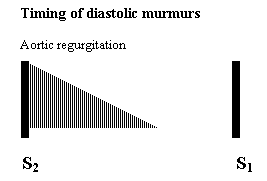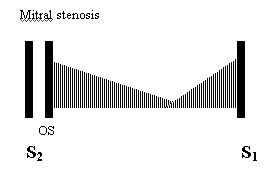| [Heart Sounds & Murmurs] | | | Liver & Ascites | | | Neck Veins | | | Pulmonary | | | Thyroid |
[Skill Modules
>>
Heart Sounds & Murmurs
>>
Techniques
]
Techniques: Heart Sounds & MurmursMurmurs (general) | Systolic | DiastolicDiastolic Murmurs
CausesDue to structural cardiac abnormality
Due to structural cardiac abnormality and increased flow
Due to increased flow
Analyze the murmur for
Where murmurs occur in diastoleDiastolic murmurs are classified as:
Early diastolic murmur
Mid-diastolic
Presystolic murmur
Where it is best heard and where it radiates to
What it sounds likeAortic insufficiencyHigh pitched, often faint, puffing, blowing quality Pulmonic regurgitationCan be high-pitched or low-pitched, often faint, blowing decrescendo. Mitral stenosisLow-pitched, rumbling murmur heard throughout diastole: a whispered letter "r".Best heard if the patient is rolled onto left side with stethoscope bell at apex. Tricuspid stenosisRumbling murmur, increases with inspiration What happens during special maneuvers/positioning?Pulmonary regurgitationIncreases with inspiration Aortic insufficiencySometimes best heard if the patient is made to site up, lean forward and breathe out fully while the stethoscope at the left side of the lower part of the sternum. Mitral stenosisBest heard as the patient is rolled onto left side with stethoscope bell at apex. Better heard after exercise. Aortic regurgitation (aortic insufficiency)Defective closure of the aortic valve with blood return from the aorta to the LV during diastole Chronic aortic regurgitationCharacterized by:
Murmur
|
||||||||||||||||||||||||||||||||||||||||||||

